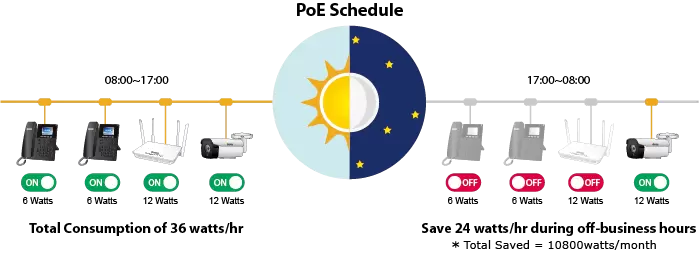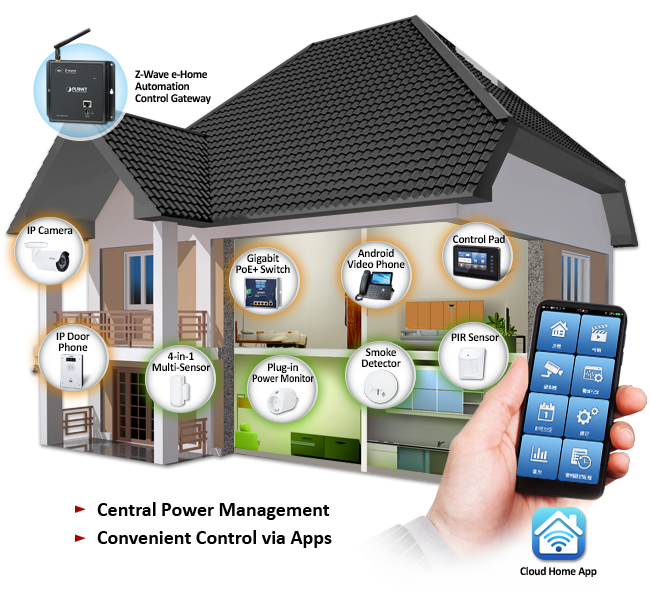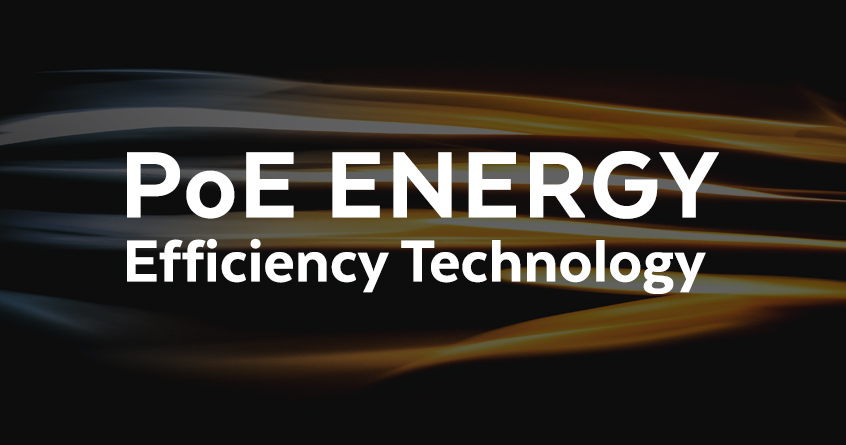Power over Ethernet (PoE) technology enables power delivery to devices via Ethernet cabling and eliminates the need for separate power cables and outlets. The widespread use of PoE power devices helps reduce energy use since these devices draw less power, allowing businesses and property owners to save on energy costs and lowering global energy demand. PoE energy efficiency is an important factor in the power consumption of devices within a network, impacting energy savings.
How PoE Enhances Energy Efficiency and Its Benefit in Smart Buildings
Reduces Power Consumption
PoE devices draw less power than legacy devices since they are smart and can turn on and off automatically. Power sourcing equipment (PSE) delivers 30 Watts to powered devices (PD) and includes multiple power supplies to provide redundancy to the system. PSEs draw power from the conventional power supply unit and manage the power over the distributed Ethernet network to determine the necessary power PDs require.
When incorporating PoE on a network, it is essential to determine ways to reduce power losses to the PSEs, PDs, and power supplies along the channel, including the connectors, cables, and patch panels. The energy efficiency of PoE technology calls for an ideal technological approach to improve the development of the network.
Some key considerations include:
- PoE systems with remote management capabilities allow network upgrades without requiring infrastructure changes.
- Reduction in size, cost, and complexity of front-end integrated circuits (IC) in devices like IP phones, WLAN access points, cameras, and other PDs.
- The ability of Ethernet cables to support four-pair powering is essential for minimizing cable power losses.
Centralizes Power Management
PoE is a marriage of power and data in one cable, allowing for smart monitoring and control of PDs and digital signage. Centralized PoE networks are also equipped with Uninterruptible Power Systems (UPS) to ensure the continuous operation of PDs during power outages. The power consumption of the various PDs in a network can vary significantly based on manufacturer requirements. PSEs must ensure power delivery to a PD across 100 meters of Ethernet cable and should not exceed its specifications.
PoE has changed how energy is used at an industrial level, primarily by integrating intelligent control systems and IoT sensors to monitor and change the power usage profile of buildings. These systems drive industrial processes towards energy efficiency, cost reduction, and reduced emissions. Network analytic and data management platforms enable consumers to optimize their energy usage and improve their energy management through:
- Smart meters that provide real-time access to energy consumption data.
- Platforms for data management, analysis, reporting, and visualization that are simple to set up.
- Energy analytics and control solutions that optimize energy generation and utilization.
Provides Power Scheduling and Automation
PoE features power management capabilities that can help ensure power is delivered to the devices that need it the most. PSEs deliver power to PDs based on how recently and frequently the device is used. Based on the device’s usage patterns, PSEs limit the power to a device when it’s inactive. Next generation PoE devices also support the high-power demands of industrial automation systems and auxiliary power supplies suitable for application in energy-intensive fields.
 Power systems evolve as technology and new standards are developed, and equipment is upgraded or updated. Whether for a new or retrofit installation, PoE should support effective power management applications like:
Power systems evolve as technology and new standards are developed, and equipment is upgraded or updated. Whether for a new or retrofit installation, PoE should support effective power management applications like:
- Generation of emergency and backup power.
- Schemes for automatic power transfer.
- Automation of stations.
- Integration of essential secure power applications.
Energy Monitoring and Reporting
On a PoE network, there are many ways to access the connected devices’ energy consumption data, including real-time streaming and historical data. Cloud-based tools and programs, like virtual assistants, allow you to collect and share energy usage data with analysis platforms for easier energy management and support. The data allows you to determine the power capabilities of your PoE network and if it can allow for adding more connected devices.
Power distribution on PoE networks is a great way to achieve energy savings in distributed systems like public lighting systems (PLSs). These different energy-saving options impact your network in varied sectors. Direct energy-saving options can include energy-efficient luminaires and renewable energy sources, while indirect options include transactive energy and energy storage systems.
Integration With Energy Management Systems
Building Management Systems (BMS) are a critical component of modern buildings. When integrated with technologies like PoE and API integration, they help improve energy efficiency and reduce the system’s carbon footprint. PoE enhances the capabilities of the BMS system by simplifying power and data distribution throughout the building, making it easier for a BMS to monitor and control various devices.
PoE networks enable the BMS to analyze and respond to real-time data, like auto-adjusting HVAC settings based on a building’s occupancy, all to ensure energy is not lost cooling and heating empty spaces. Similarly, the BMS can control devices like access points and lighting on the PoE network by turning them off in unoccupied spaces. Automatic power management leads to a reduction in energy costs and a more sustainable building operation.
Compliance With Energy Efficiency Standards
PoE devices must be able to transmit power and data over long cables for PDs to operate effectively. A PoE network works best when the design and installation stages are modeled to fit your unique requirements. PSEs should provide up to 30 Watts of power to the PDs on the network using the PoE+ standard. Well-designed PSEs have built-in thermal management and power surge protection to protect PoE devices from excessive heat and power spikes while delivering a steady flow of power to the PDs.
The contribution of PoE to power supply solutions is key to energy sustainability and delivery. PoE continues to leverage emerging smart technologies to create intelligent energy management and storage solutions for consumers. Capitalizing on this technology can improve the efficiency of power distribution systems and limit any losses.
The Verdict
Power over Ethernet solves the problem of powering devices that are not physically close to a power source. It is a convenient and dependable way to power and connect devices on a network. The convenience of delivering power and data connectivity with a single cable makes PoE a ubiquitous power source for many network devices. PoE advances single-cable solutions by focusing on applications that benefit from simplicity and energy efficiency.
Versa Technology is a leading provider of networking technology and PoE products. Contact us today to find the right PoE technologies and solutions for your networking needs.

